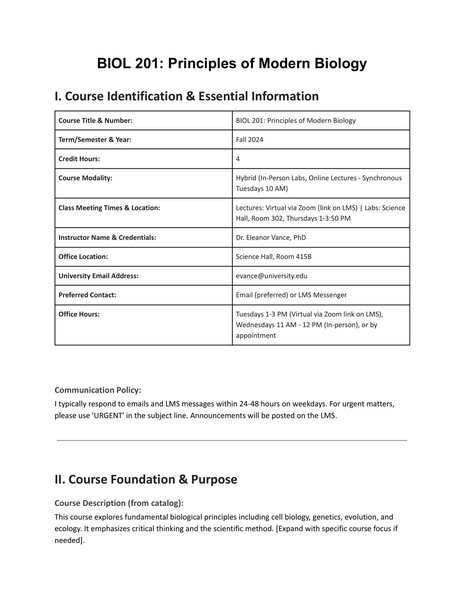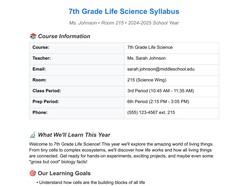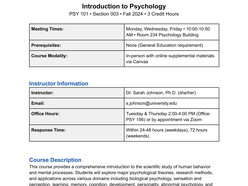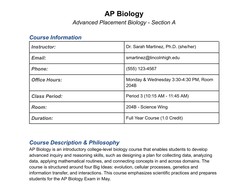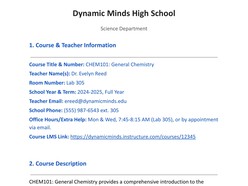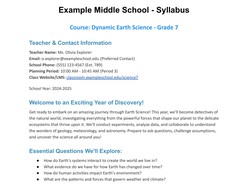A clear, well-structured syllabus is fundamental to course organization and student success. This Google Docs template provides a robust framework for creating professional, modern college and university syllabi, ensuring all essential components are addressed effectively.
Designed for instructors, professors, and teaching assistants across all post-secondary disciplines, this template simplifies the syllabus creation process. It helps articulate course expectations, learning outcomes, policies, and schedules with clarity, while maintaining a professional and accessible format. Use it to establish a clear contract with students and provide a go-to reference throughout the semester.
Key Features:
- Clearly Organized Course & Instructor Details: Pre-defined sections for course number, title, instructor contact, office hours, and communication policy.
- Dedicated Space for SMART Learning Outcomes: Prompts for specific, measurable, achievable, relevant, and time-bound learning objectives.
- Pre-formatted Weekly Schedule Table: Easily input topics, readings, assignments, and due dates in a structured, readable format.
- Comprehensive Assignment Descriptions & Grading Policies: Sections to detail major assignments, their alignment with learning outcomes, and explicit grading criteria.
- Sections for Key Institutional Policies: Placeholders for Academic Integrity, AI Use, Disability Accommodations, DEI statements, and Title IX information.
- Student Support & Wellness Resources Area: Designated space to list campus mental health, basic needs, and academic support contacts.
- Professional Formatting: Clean headings, organized tables, and readable fonts for a modern, accessible document.
Format: Google Docs
How To Use This Free Syllabus Template
Step 1: Access the Template
To begin, you'll open and make a copy of the template in Google Docs:
- Click the [Access Syllabus Template] button (this would be your actual download/access link).
- If prompted, select the "Use Template" button in the top-right corner (for templates shared via Google's template gallery) OR select "File" > "Make a copy" (for standard shared documents).
- Ensure you are signed into your Google account. The template will be saved to your Google Drive, ready for editing.
Step 2: Personalize Core Course Information
Replace the placeholder text in the initial sections with your specific details:
- Course Identification: Title, number, term, credit hours, modality, meeting times/location.
- Instructor Information: Name, credentials, contact details, office hours, communication policy.
Step 3: Populate Content Sections
Work through each major section, inputting your course-specific content:
- Course Foundation: Description, prerequisites, learning outcomes (make them SMART).
- Materials & Technology: Required texts, software, and tech support info.
- Assignments & Grading: Detailed descriptions of assignments, their weight, grading scale, and late policies. Link or describe rubrics.
- Weekly Schedule: Fill in the table with topics, readings, and due dates for each week or module.
Step 4: Integrate Institutional Policies
Adapt the placeholder policy sections to match your institution's official wording and requirements:
- Academic Integrity/Honor Code
- AI Use Policy (crucial to define clearly)
- Disability Services & Accommodation
- Diversity, Equity, and Inclusion (DEI)
- Title IX Information
- Land Acknowledgment (if applicable)
- Add any other institution-specific or department-specific policies.
Step 5: Add Student Support Resources
Populate the sections for:
- Mental Health & Wellness services
- Basic Needs (food pantry, emergency aid)
- Academic Support (tutoring, writing center)
- Library and other relevant campus resources.
Step 6: Review, Finalize & Distribute
Thoroughly review the entire syllabus for accuracy, completeness, and clarity.
- Proofread carefully.
- Check that all links are functional.
- Once satisfied, save the document.
- Distribute to students via your Learning Management System (LMS), email, or as a printed handout, as per your usual practice. Update it as needed throughout the semester, notifying students of any changes.
Benefits of Using This Template:
- Save Significant Time: Streamlines the syllabus creation process with a ready-to-use structure.
- Ensure Comprehensiveness: Helps cover all critical information required in a modern syllabus.
- Promote Clarity & Consistency: Provides a clear, organized layout for students.
- Modern & Professional Appearance: Presents course information in a polished, contemporary format.
- Fully Editable in Google Docs: Easily customize all content, add or remove sections, and adapt to specific course needs.
